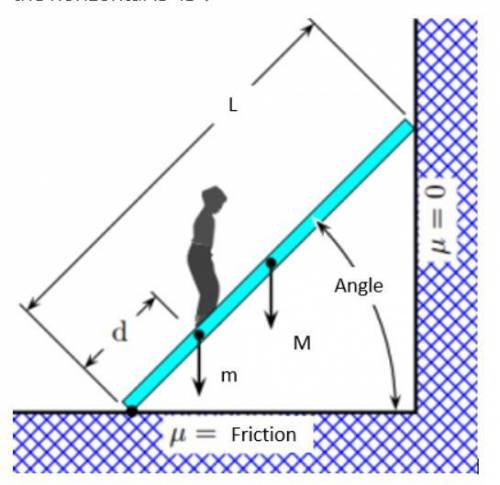
Physics, 03.03.2020 08:07 kaishasenat1986
A 67 kg person climbs up a uniform 12 kg ladder. The ladder is 5 m long; its lower end rests on a rough horizontal floor (static
friction coefficient 0.39) while its upper end rests against a frictionless vertical wall. The angle between the ladder and the horizontal is 43◦.
Let d denote the climbing person’s distance from the bottom of the ladder (see the above diagram). When the person climbs too far (d > dmax), the ladder slips and falls down (kaboom!). Calculate the maximal distance dmax the person will reach before the ladder slips. The
acceleration of gravity is 9.8 m/s*s. Answer in two decimal places max.


Answers: 3
Another question on Physics

Physics, 22.06.2019 00:20
Consider the particle-in-a-box problem in 1d. a particle with mass m is confined to move freely between two hard walls situated at x = 0 and x = l. the potential energy function is given as (a) describe the boundary conditions that must be satisfied by the wavefunctions ψ(x) (such as energy eigenfunctions). (b) solve the schr¨odinger’s equation and by using the boundary conditions of part (a) find all energy eigenfunctions, ψn(x), and the corresponding energies, en. (c) what are the allowed values of the quantum number n above? how did you decide on that? (d) what is the de broglie wavelength for the ground state? (e) sketch a plot of the lowest 3 levels’ wavefunctions (ψn(x) vs x). don’t forget to mark the positions of the walls on the graphs. (f) in a transition between the energy levels above, which transition produces the longest wavelength λ for the emitted photon? what is the corresponding wavele
Answers: 1

Physics, 22.06.2019 02:00
An object has a weight of 500 on earth what is the mass of this object
Answers: 1

Physics, 22.06.2019 14:40
The experiment done in lab is repeated, using a ball that has unknown mass m. you plot your data in the form of f 2 versus m/l, with f in rev/s, m in kg, and l in m. your data falls close to a straight line that has slope 3.19 m/(kg · s2). use g = 9.80 m/s2 and calculate the mass m of the ball.
Answers: 1

Physics, 22.06.2019 15:00
Holes drilled several kilometers into earth’s crust provide direct evidence about earth’s interior in the form of
Answers: 1
You know the right answer?
A 67 kg person climbs up a uniform 12 kg ladder. The ladder is 5 m long; its lower end rests on a ro...
Questions


English, 01.10.2019 06:30

Biology, 01.10.2019 06:30



Mathematics, 01.10.2019 06:30


Mathematics, 01.10.2019 06:30


English, 01.10.2019 06:30





Mathematics, 01.10.2019 06:30

Health, 01.10.2019 06:30

History, 01.10.2019 06:30





